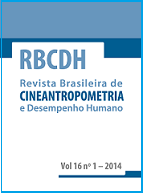Body image perception in women: prevalence and association with anthropometric indicators.
DOI:
https://doi.org/10.1590/1980-0037.2014v16n1p58Abstract
The aim of this study was to investigate the prevalence of body image perception and its association with anthropometric indicators (body mass index, waist circumference, waist-height ratio, and conicity index) in women undergoing cervical cancer screening at an institution in Florianópolis, Santa Catarina. The study included 736 women (? 18 years). Anthropometric variables (weight, height, waist circumference) were collected for the determination of body mass index, waist-height ratio, and conicity index. Body image perception was evaluated using a nine-body silhouette scale. The prevalence of body image dissatisfaction was 73% (dissatisfaction due to excess weight = 67.4%; dissatisfaction due to thinness = 5.6%). Overweight women (PR=1.34; 95%CI=1.23-2.49, p<0.001) and women with an inadequate conicity index (PR=1.12; 95%CI =1.02-1.24, p=0.016) presented a higher prevalence of body image dissatisfaction. The prevalence of body image dissatisfaction is high and the proportion of inadequate anthropometric indicators requires attention. Moreover, body dissatisfaction was more prevalent among overweight women and women with an inadequate conicity index. These results indicate the need for interventions and for the implementation of programs designed to control body weight and to reduce cardiovascular risk factors and body image dissatisfaction in women attending primary health care centers, such as cancer screening services.



